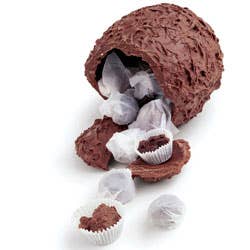
Receiving a Lagomarcino filled Easter egg," says Tom Lagomarcino, a second-generation candymaker based in Moline, Illinois, "is like getting a box of chocolates and being able to eat the box." The company's hand-textured eggshells consist of chocolate tops and bottoms glued together with more chocolate. When broken open, they reveal an assortment of exquisite homemade chocolate creams, nut clusters, and (in the three largest sizes) dipped fruits, all individually wrapped in tiny squares of white confectionery paper.
Angelo Lagomarcino, an immigrant from Liguria, in northern Italy, founded his jewel-like candy shop and soda fountain, with its mahogany booths, decorative lamps, and snowflake-patterned tile floor, in Moline in 1908. Not long thereafter, he introduced his customers to the filled Easter egg, a European tradition that had never really caught on in the United States—perhaps because it was just too labor intensive. Today, the eggs are a Lagomarcino signature. Many customers order one every year as a centerpiece for their Easter supper; standard protocol is to cut off the tip of the egg after the meal so that guests may nibble on the shell and the goodies inside. And more than once a romantic patron has asked Lagomarcino's to hide a diamond ring among the chocolates.
The eggs come in five sizes, with either a milk- or a dark-chocolate shell. The largest egg, which resembles a football, weighs in at about 3 1/2 pounds, contains approximately 70 pieces of chocolate; the smallest is about 14 ounces, and holds 20 or so confections. The shop also makes special eggs for children that are filled with a mix of jelly beans, M&M's, and candy chicks and bunnies.
Keep Reading
Continue to Next Story










